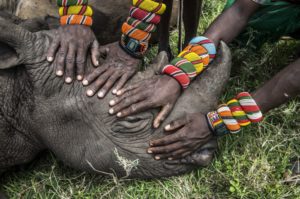Getting that perfect photo can be hard; for photographer Ami Vitale, getting the right photo means spending time learning the stories of wherever she is. Vitale is a photographer for National Geographic and an ambassador for Nikon; she has spent time in almost 100 countries honing her art and telling the stories of the people and wildlife she comes across. Vitale says that constant effort and a want to grow as a person allowed her to end up where she’s at today.
“Photography was basically this way of overcoming my fear of people. I was incredibly introverted and shy, but when I picked up a camera, it all of a sudden gave me a reason to be with people and explore. It became a passport for me in a way,” says Vitale. “It wasn’t until I started to produce these works of art that started to gather some traction that I got noticed by National Geographic. It took a long time.”

Vitale will be giving a talk on her journey at the Royal Theatre; she says that she hopes to bring attention to some of the issues going on in our world right now and to showcase that no matter where in the world they are, most people want peace and hope.
“I think now more than ever the world feels so polarized. You turn on the news and all of a sudden we’re talking about nuclear war… I think we need to tone it down,” she says. “I think if we only sit and watch the news from our armchair, the world looks like this terrifying place. My message is that everywhere I go, there’s so much more, and that most people on this planet want the same things. I think it’s a matter of getting a much more accurate look of what the world really looks like and to remind people of what we can achieve. There are a lot of hopeful stories out there.”
Vitale’s work mainly consists of photos of people, but many of her shots centre on wildlife. She says that we all have to work together to maintain the balance of our planet, adding that recent events across the globe prove that we need to start taking action fast and that we need to respect the world we live in.
“We can’t talk about wildlife without talking about people,” she says. “We have to coexist on this planet and we only have one planet. I think everybody knows; it’s like watching the future unfold in slow motion. We’re watching this happening and we understand it. This summer was a great illustration—between forest fires, flooding, landslides, and hurricanes, weather is becoming more violent more frequently. The wildlife pieces are really these stories about how intricately we are connected on this planet and how I’m searching for the way forward from these seemingly big, intractable problems.”
Vitale says that some advice she would offer to aspiring photographers is to focus on the stories behind the pictures rather than focusing on the picture itself.
“An image can be beautiful, but that’s not enough,” she says. “If you really want to make it to this level, pick up National Geographic and realize it’s not just pretty pictures. The craft of what we do is really about storytelling. Every image needs to tell a story. All the images need to work together to tell that story. My advice would be to pick a story in your backyard and for a minimum of a year work on only that. Until you start to reveal something deep and meaningful that teaches us something, it’s just not enough to take a pretty picture.”
Rhinos, Rickshaws, and Revolutions
7 pm Wednesday, January 24
$20 to $54.50, Royal Theatre
rmts.bc.ca
